You might be wondering if a 1959 penny found in your pocket change is worth keeping — and the answer is: sometimes, yes!
While many 1959 pennies are only worth face value, some can be quite valuable, depending on their condition, rarity, and type. In this guide, we’ll look at the history, key features, and value of 1959 pennies to help you spot which ones might be worth holding onto — or even selling.
Let’s dive in!
1959 Penny Value Chart
(Values shown are for red (RD) graded coins unless otherwise noted)
Regular Strike Coins (Business Strikes):
| Mint Mark | MS63 | MS65 | MS67 |
|---|---|---|---|
| 1959 (P) No Mint Mark | $6 | $18 | $600 |
| 1959 D (Denver) | $4 | $18 | $275 |
Proof Coins:
| Grade | PR60 | PR65 | PR69 |
|---|---|---|---|
| Standard Proof | $5 | $15 | $450 |
| Cameo Proof | $10 | $30 | $2,000 |
| Deep Cameo Proof | $14 | $70 | $21,500 |
What Makes a 1959 Penny Special?
- Grade & Condition: Higher grades (MS or PR 65+) are worth more, especially in pristine, uncirculated condition.
- Color Designation: Red coins (RD) are more desirable than red-brown (RB) or brown (BN).
- Proof Type: Proof coins, especially Cameo and Deep Cameo, are significantly more valuable.
- Mint Mark: Check for the D for Denver or the absence of a mint mark (Philadelphia).
- Rarity & Errors: Rare error coins or varieties can fetch thousands of dollars.
History of the 1959 Penny

The year 1959 marked the 150th anniversary of President Abraham Lincoln’s birth, and with it came a redesign of the penny to honor the occasion. While coins had already featured Lincoln’s portrait since 1909, the U.S. Mint saw this milestone as an opportunity to refresh the design.
The original Lincoln cent, introduced in 1909, was groundbreaking—it was the first U.S. coin to feature a real person rather than a symbolic figure. Its reverse design, featuring two wheat stalks, earned it the nickname “wheat penny.”
In 1959, while the obverse still featured Lincoln’s bust, the reverse was updated to showcase the Lincoln Memorial in Washington, D.C., replacing the wheat ears. This new design was created by Frank Gasparro, who was serving as the Mint’s Assistant Engraver at the time.
Nearly 2 billion pennies were minted in 1959. The Denver Mint was responsible for the bulk of the production, while the Philadelphia Mint handled the rest, including over one million proof coins, created in response to high public interest in the new design.
The Lincoln Memorial reverse remained in use for the next 50 years, making it one of the longest-standing reverse designs in U.S. coin history. In 2009, to mark the bicentennial of Lincoln’s birth, the design changed once again—this time to the Union Shield, which still appears on modern pennies today.
Features of the 1959 Penny
The Obverse of the 1959 Penny
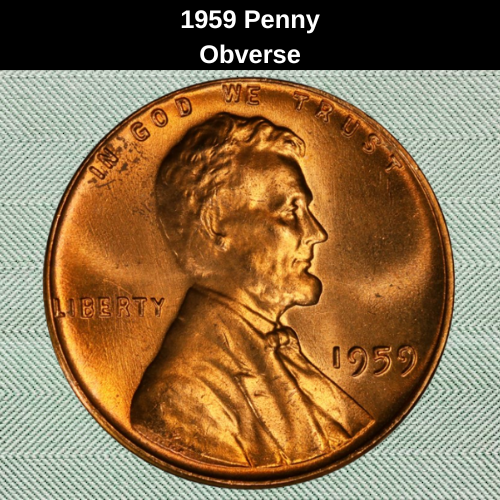
The obverse of the 1959 penny features a portrait instantly recognizable to Americans: President Abraham Lincoln in profile, facing right. This iconic image has appeared on every Lincoln cent since its introduction in 1909.
The portrait was created by Victor David Brenner, who said he envisioned Lincoln as he might have looked reading a story to a child. It’s widely believed that Brenner based his design on a photograph taken at the studio of Matthew Brady, a famous Civil War-era photographer. While some historians credit Brady himself with taking the photo, others suggest it may have been the work of one of his assistants.
Brenner originally wanted to sign his design on the obverse, but was told that wouldn’t be permitted. Instead, he placed his initials (V.D.B.) on the reverse of the 1909 coins. Even that sparked controversy—critics argued that the initials were too prominent and acted as self-promotion. In response, the Mint removed them.
For nearly a decade, the Lincoln cent bore no artist’s signature. But in 1918, Brenner’s initials were quietly restored—this time on the obverse, just as he had originally planned. They were discreetly placed at the bottom edge of Lincoln’s shoulder, and they’ve remained in that location ever since. You can still spot them on 1959 pennies.
The coin also includes the national motto “IN GOD WE TRUST” along the upper rim. On the left side, behind Lincoln, you’ll find the word “LIBERTY”, while the date appears on the lower right. If your coin was struck at the Denver Mint, you’ll also see a small “D” mint mark just beneath the date. Philadelphia-minted coins from 1959, on the other hand, have no mint mark.
The Reverse of the 1959 Penny
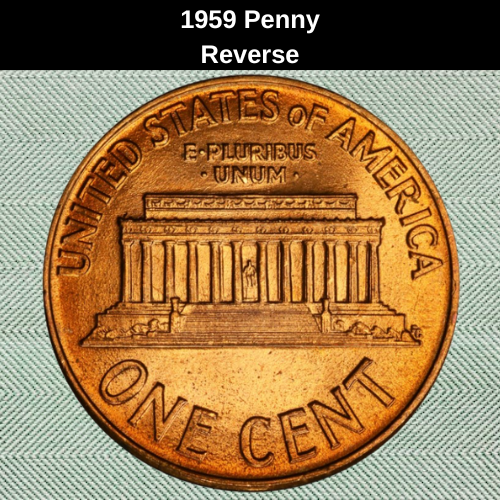
The 1959 penny was the first to feature the Lincoln Memorial on its reverse, replacing the earlier wheat ears design.
If you look closely at the memorial’s portico, you can actually see the statue of Abraham Lincoln seated inside. This detail makes the Lincoln Memorial penny one of the few U.S. coins to depict the same person on both sides.
The coin’s denomination, “ONE CENT,” appears in bold capital letters along the lower edge of the reverse. Arched along the top rim are the words “UNITED STATES OF AMERICA.”
Just beneath that inscription, you’ll find the Latin motto “E PLURIBUS UNUM” displayed in two lines. This phrase translates to “Out of many, one,” reflecting the formation of the United States from multiple individual states.
Other Features of the 1959 Penny
The 1959 Lincoln penny has a diameter of 19 millimeters and weighs 3.11 grams. It’s composed of 95% copper and 5% zinc, matching the specifications of the Wheat pennies minted the year before.
Because of its high copper content, the coin’s color changes over time. When freshly minted, the penny displays a bright red hue. As it ages and is exposed to air and handling, that red gradually fades to a brown tone.
Grading agencies classify Lincoln cents into three color categories based on surface appearance:
- Red (RD) – Bright, original copper color on at least 95% of the surface
- Red and Brown (RB) – Mixed tones of red and brown
- Brown (BN) – A fully toned, darker brown appearance
Generally, red pennies are the most valuable, while brown coins tend to be worth the least. Red and brown coins fall somewhere in between.
If you’re curious about how grading works in practice, check out CoinOpp’s YouTube video for a visual guide on grading Lincoln penny colors.
1959 Penny Grading
| # | Grade |
|---|---|
| 1 | Basal State-1 |
| 2 | Fair |
| 3 | Very Fair |
| 4, 5, 6 | Good |
| 7, 8, 10 | Very Good |
| 12, 15 | Fine |
| 20, 30 | Very Fine |
| 40 | Extremely Fine |
| 50 | About Uncirculated |
| 60 | Mint State |
| 65 | Mint State |
| 70 | Mint State |
Please check our grading guides to know your coin scale, It’s the necessary step to know the exact value of your coin.
1959 Penny Value Guides
1959 (P) No Mint Mark Penny Value
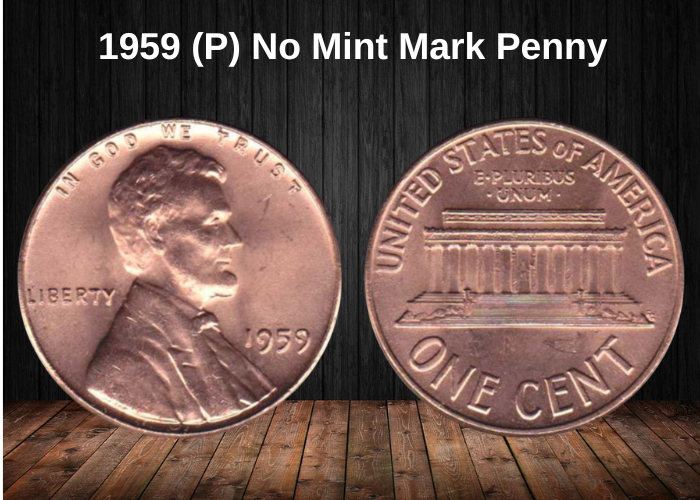
In 1959, the Philadelphia Mint produced fewer than half the number of Lincoln pennies compared to the Denver Mint. As a result, pennies without a mint mark (Philadelphia) are typically more valuable than those with a “D” (Denver)—especially in better condition.
Coin condition is graded on a scale from 1 to 70, where 1 represents the poorest identifiable coin, and 70 denotes a perfect, flawless specimen.
Another key factor is color. Most brown or red-brown 1959 pennies won’t fetch more than face value unless they have a notable error. But a red penny in mint state (MS) can command a much higher price.
- A red 1959 Philadelphia penny must be graded at least MS63 to have collector value. At that level, it’s worth about $6.
- A gem quality MS66 red coin might sell for around $28.
- Step up to MS66+, and the PCGS values it at approximately $70.
- An MS67 red penny could reach $600 in the current market.
At the very top of the scale, there are only four known 1959 Philly cents graded MS67+, and each is valued at $3,000.
1959 D Penny Value
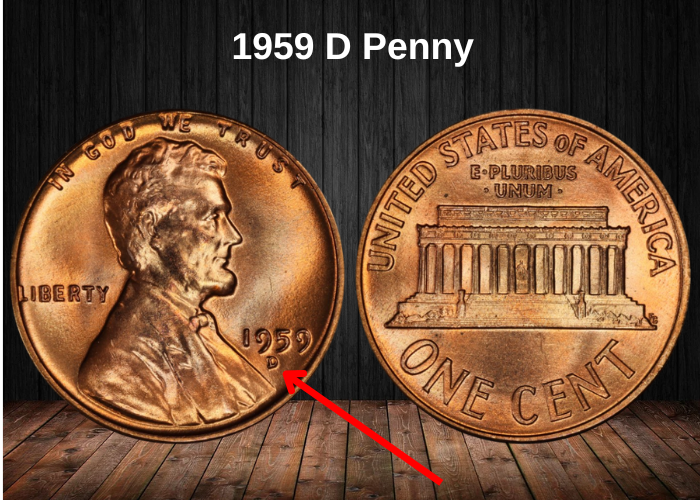
The Denver Mint was responsible for producing over two-thirds of all pennies struck in 1959. So, if your coin has a small “D” beneath the date, it’s one of many!
According to PCGS, an estimated 200,000 examples of the nearly 1.3 billion Denver pennies still survive today. Surprisingly, about half of those are in gem quality condition (graded MS65 or higher).
Because of the high mintage, values are generally lower for Denver pennies compared to those from Philadelphia—especially at lower grades. As with other Lincoln cents, the color matters: only red coins in excellent condition are typically worth more than face value.
- A red 1959-D penny graded MS63 is worth around $4
- At MS66+, values rise to about $60
- A red MS67 Denver penny is worth approximately $275
- At MS67+, that figure jumps to $2,700
The top-known example from Denver is a single coin graded MS68, with an estimated value of $9,000.
1959 (P) No Mint Mark Proof Penny Value
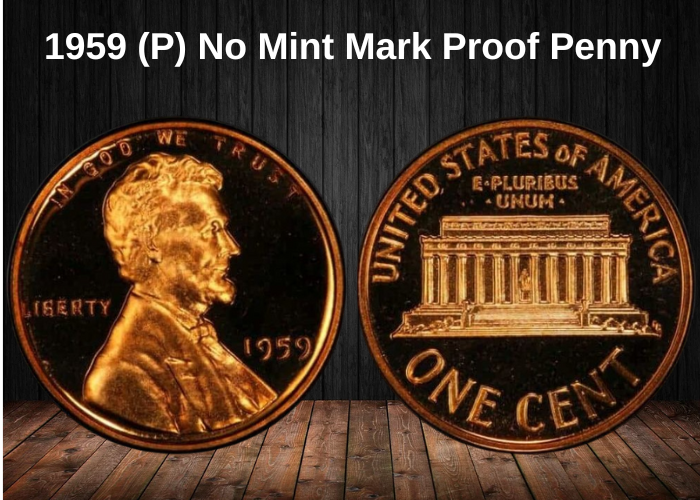
In 1959, the Philadelphia Mint produced 1,149,291 proof pennies. These coins were struck using highly polished planchets and special dies, resulting in superior quality specifically made for collectors.
All 1959 proof pennies are red, since they were never released into circulation. However, their value varies based on the finish quality:
- A coin with a strong contrast between shiny backgrounds (called fields) and frosted raised areas is known as a cameo.
- If this contrast is especially deep and striking, it’s classified as a deep cameo (DCAM).
- Generally, cameos are more valuable than standard proofs, and deep cameos are the most valuable.
1959 Red Proof Values
- PR60 Red – $5
- PR65 Red – $15
- PR67+ Red – $45
- PR68 Red – $100
- PR69 Red (finest known, only 4 exist) – $450
1959 Cameo Proof Values
- PR60 CAM – $10
- PR65 CAM – $30
- PR69 CAM – $2,000
1959 Deep Cameo Proof Values
- PR60 DCAM – $14
- PR65 DCAM – $70
- PR69 DCAM – $21,500
1959 stands out as a strong year for cameo-proof cents, with more surviving specimens than any other year in the 1950s.
Rare 1959 Penny Error List
1959 D Mule Penny
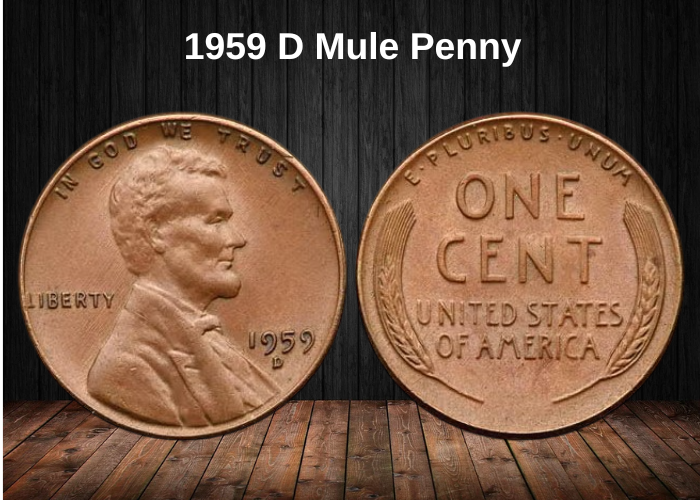
1959 marked the debut of the Lincoln Memorial reverse on U.S. pennies. However, at least one coin reportedly struck at the Denver Mint featured the old Wheat penny reverse—a design officially retired the previous year.
Coins that mistakenly combine designs from different types or years are known as “mules.” These mint errors are extremely rare and highly valuable due to their unintentional nature.
But this particular coin came with serious controversy.
- The U.S. Treasury issued a letter confirming the coin’s authenticity, but the evaluation had been made by a currency specialist, not a numismatist.
- When submitted to professional coin grading services, they refused to authenticate it.
- In 2002, just before it was to be auctioned, Mark Hofmann—a convicted forger—wrote to his daughter claiming he had created the fake.
- As a result, the coin was withdrawn from sale.
Eight years later, the penny resurfaced at auction. Although no conclusive evidence had proven it to be a forgery, it was listed with a disclaimer stating its authenticity couldn’t be guaranteed.
Despite the uncertainty, a collector paid $31,050 to own the mysterious coin.
1959 (P) No Mint Mark Double Die Obverse Penny
A far less controversial error than the mule is the Double Die Obverse variety of the 1959 Philadelphia penny.
This error occurred during the die production process, when the die used to strike the front (obverse) of the coin was improperly aligned during multiple impressions from the hub. The result was a slightly doubled image that was then transferred to every coin struck by that die.
Multiple dies were affected, leading to several varieties of this error. The most sought-after is known as FS-101, which shows clear doubling on the word “LIBERTY” and the date.
Depending on its condition, this error coin can be worth:
- $18 in MS60
- Up to $850 in MS66, the highest grade known for this variety
Where to sell your penny?
Now that you know the value of your penny, you might be wondering where to sell it. Don’t worry: here’s a guide to some of the best online platforms where you can easily sell your coins, along with their advantages and disadvantages.
Discover the best platforms for selling coins online (pros and cons).
FAQs
1. Why is the 1959 Lincoln Penny historically significant?
The 1959 Lincoln Penny marks a major design transition in U.S. coinage. It was the first year the Wheat reverse was replaced by the Lincoln Memorial design, commemorating the 150th anniversary of Abraham Lincoln’s birth. This design change made the 1959 penny a milestone in the history of American numismatics.
2. What are the key design changes from the 1958 Wheat Penny to the 1959 Lincoln Penny?
- Reverse Design:
- Before (1909–1958): Wheat ears on both sides of the words “ONE CENT”.
- After (1959–2008): The Lincoln Memorial, designed by Frank Gasparro.
- Obverse Design: Lincoln’s portrait by Victor D. Brenner remained unchanged.
- The Lincoln Memorial reverse included a tiny image of the Lincoln statue inside the memorial — making Lincoln the first U.S. president depicted on both sides of a coin.
3. What is the composition of the 1959 Lincoln Memorial Penny?
The 1959 penny was struck in the traditional 95% copper and 5% tin and zinc alloy — the same composition used since 1909 (excluding the steel pennies of 1943). It weighs 3.11 grams.
4. How many 1959 Lincoln Pennies were minted?
- Philadelphia Mint (no mintmark): 609,715,000
- Denver Mint (D): 1,279,760,000
Together, over 1.88 billion 1959 pennies were minted, making them extremely common in circulation.
5. Are there any rare or valuable 1959 Lincoln Pennies?
Yes, especially the 1959-D Wheat Reverse Error Penny, a highly controversial coin.
- 1959-D Wheat Reverse: A small number of pennies have been found with the Wheat reverse design but a 1959-D date. These coins are not supposed to exist, as no Wheat cents were officially minted after 1958.
- Only one authenticated example is known, discovered by Roy Gray in the 1980s.
- This coin sold at auction for over $50,000 and has been subject to debate among numismatists regarding its legitimacy (mint error vs. alteration).
6. What is the value of a regular 1959 Lincoln Penny today?
- Circulated condition: Typically 1 to 5 cents
- Uncirculated MS-60 to MS-63: Around $0.15 to $0.50
- High-grade MS-65+ coins: Can sell for $1 to $5+
- Proof versions (from Philadelphia only): Worth $1 to $10, depending on grade
Because of their high mintage and availability, most 1959 pennies are not highly valuable — except in pristine condition or error varieties.
7. Are there any other errors or varieties from 1959 that are collectible?
While not as famous as the Wheat Reverse error, collectors should look for:
- Double Die Obverse (DDO): Doubling on “LIBERTY” or the date can increase value.
- Die Cracks and Cuds: Minor minting flaws like die breaks or extra metal blobs.
- Off-Center Strikes: Misaligned strikes are more noticeable and can add value.
Though relatively rare, these error varieties make certain 1959 pennies more desirable to collectors.


















































